KIA RIO 2022 Owners Manual
Manufacturer: KIA, Model Year: 2022, Model line: RIO, Model: KIA RIO 2022Pages: 528, PDF Size: 11.8 MB
Page 331 of 528
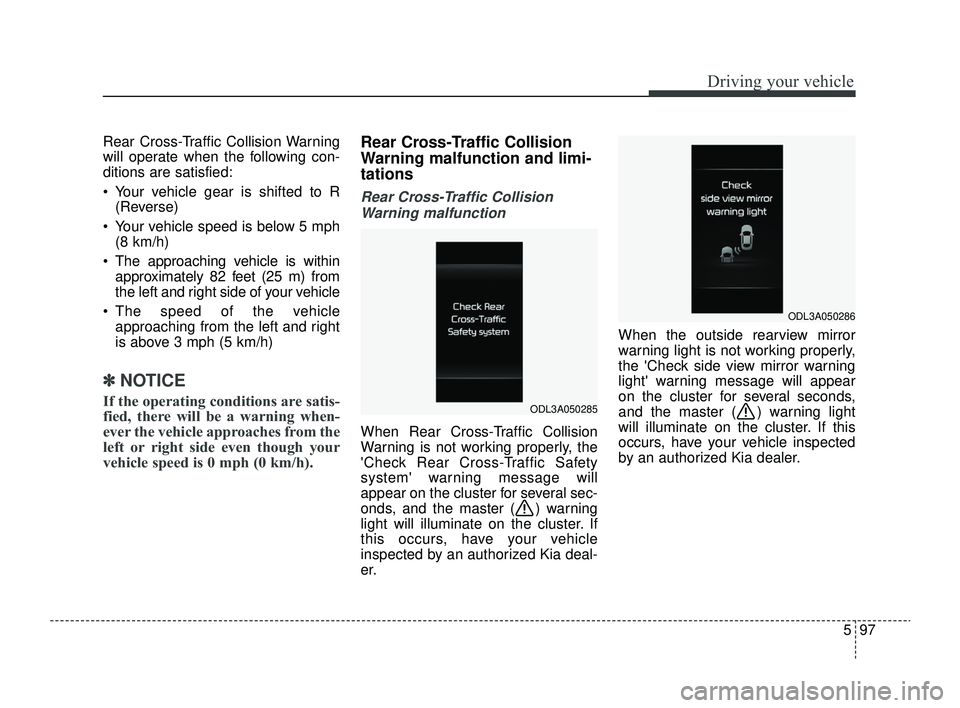
597
Driving your vehicle
Rear Cross-Traffic Collision Warning
will operate when the following con-
ditions are satisfied:
Your vehicle gear is shifted to R(Reverse)
Your vehicle speed is below 5 mph (8 km/h)
The approaching vehicle is within approximately 82 feet (25 m) from
the left and right side of your vehicle
The speed of the vehicle approaching from the left and right
is above 3 mph (5 km/h)
✽ ✽
NOTICE
If the operating conditions are satis-
fied, there will be a warning when-
ever the vehicle approaches from the
left or right side even though your
vehicle speed is 0 mph (0 km/h).
Rear Cross-Traffic Collision
Warning malfunction and limi-
tations
Rear Cross-Traffic Collision
Warning malfunction
When Rear Cross-Traffic Collision
Warning is not working properly, the
'Check Rear Cross-Traffic Safety
system' warning message will
appear on the cluster for several sec-
onds, and the master ( ) warning
light will illuminate on the cluster. If
this occurs, have your vehicle
inspected by an authorized Kia deal-
er. When the outside rearview mirror
warning light is not working properly,
the 'Check side view mirror warning
light' warning message will appear
on the cluster for several seconds,
and the master ( ) warning light
will illuminate on the cluster. If this
occurs, have your vehicle inspected
by an authorized Kia dealer.
ODL3A050285
ODL3A050286
SC PE USA 5.QXP 9/9/2021 6:22 PM Page 97
Page 332 of 528
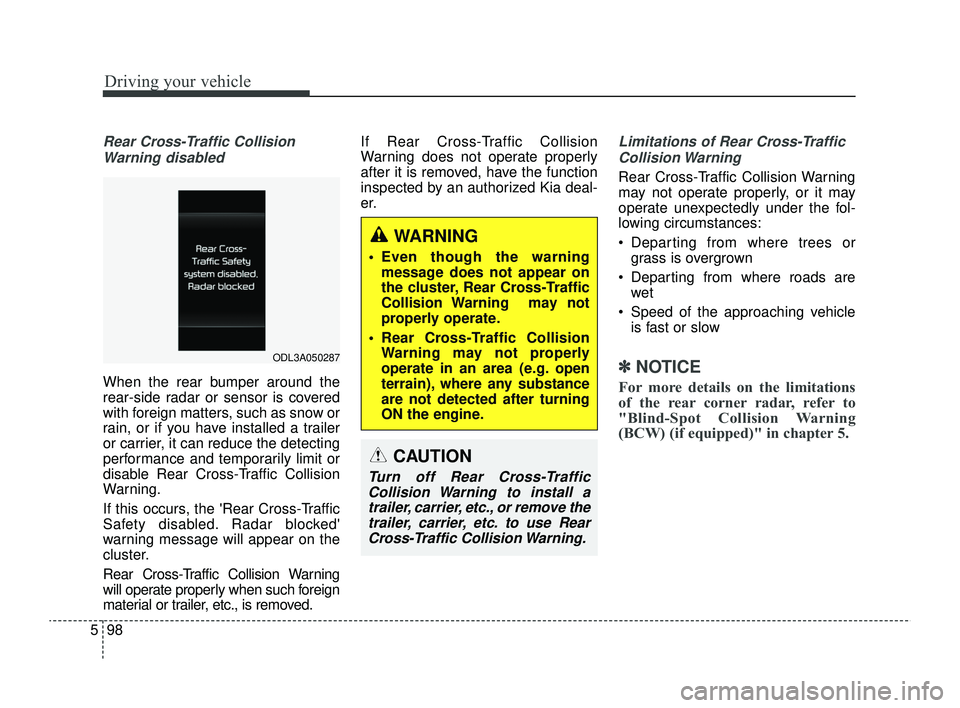
Driving your vehicle
98
5
Rear Cross-Traffic Collision
Warning disabled
When the rear bumper around the
rear-side radar or sensor is covered
with foreign matters, such as snow or
rain, or if you have installed a trailer
or carrier, it can reduce the detecting
performance and temporarily limit or
disable Rear Cross-Traffic Collision
Warning.
If this occurs, the 'Rear Cross-Traffic
Safety disabled. Radar blocked'
warning message will appear on the
cluster.
Rear Cross-Traffic Collision Warning
will operate properly when such foreign
material or trailer, etc., is removed. If Rear Cross-Traffic Collision
Warning does not operate properly
after it is removed, have the function
inspected by an authorized Kia deal-
er.
Limitations of Rear Cross-Traffic
Collision Warning
Rear Cross-Traffic Collision Warning
may not operate properly, or it may
operate unexpectedly under the fol-
lowing circumstances:
Departing from where trees or grass is overgrown
Departing from where roads are wet
Speed of the approaching vehicle is fast or slow
✽ ✽
NOTICE
For more details on the limitations
of the rear corner radar, refer to
"Blind-Spot Collision Warning
(BCW) (if equipped)" in chapter 5.
ODL3A050287
CAUTION
Turn off Rear Cross-Traffic
Collision Warning to install atrailer, carrier, etc., or remove thetrailer, carrier, etc. to use RearCross-Traffic Collision Warning.
WARNING
Even though the warning message does not appear on
the cluster, Rear Cross-Traffic
Collision Warning may not
properly operate.
Rear Cross-Traffic Collision Warning may not properly
operate in an area (e.g. open
terrain), where any substance
are not detected after turning
ON the engine.
SC PE USA 5.QXP 9/9/2021 6:22 PM Page 98
Page 333 of 528
![KIA RIO 2022 Owners Manual 599
Driving your vehicle
WARNING
[A]: Structure
Driving near a vehicle orstructure
Rear Cross-Traffic Collision
Warning may be limited when
driving near a vehicle or struc-
ture, and may not detect KIA RIO 2022 Owners Manual 599
Driving your vehicle
WARNING
[A]: Structure
Driving near a vehicle orstructure
Rear Cross-Traffic Collision
Warning may be limited when
driving near a vehicle or struc-
ture, and may not detect](/img/2/54885/w960_54885-332.png)
599
Driving your vehicle
WARNING
[A]: Structure
Driving near a vehicle orstructure
Rear Cross-Traffic Collision
Warning may be limited when
driving near a vehicle or struc-
ture, and may not detect the
vehicle approaching from the left
or right. If this occurs, the func-
tion may not warn the driver
when necessary.
Always check your surround-
ings while backing up. (Continued)
OSC050100
(Continued)
When the vehicle is in a com-plex parking environment
Rear Cross-Traffic Collision
Warning may detect vehicles
which are parking or pulling out
near your vehicle (e.g. a vehicle
leaving beside your vehicle, a
vehicle parking or pulling out in
the rear area, a vehicle
approaching your vehicle mak-
ing a turn, etc.). If this occurs,
the function may unnecessarily
warn the driver.
Always check your surround-
ings while backing up. (Continued)
OSC050101
(Continued)
[A]: Vehicle
When the vehicle is parkeddiagonally
Rear Cross-Traffic Collision
Warning may detect vehicles
which are parking or pulling out
near your vehicle (e.g. a vehicle
leaving beside your vehicle, a
vehicle parking or pulling out in
the rear area, a vehicle
approaching your vehicle mak-
ing a turn, etc.). If this occurs,
the function may unnecessarily
warn the driver.
Always check your surround-
ings while backing up. (Continued)
OSC050102
SC PE USA 5.QXP 9/9/2021 6:22 PM Page 99
Page 334 of 528
![KIA RIO 2022 Owners Manual Driving your vehicle
100
5
(Continued)
[A]: Structure, [B]: Wall
Pulling into the parking space
where there is a structure
Rear Cross-Traffic Collision
Warning may detect vehicles
passing by in fron KIA RIO 2022 Owners Manual Driving your vehicle
100
5
(Continued)
[A]: Structure, [B]: Wall
Pulling into the parking space
where there is a structure
Rear Cross-Traffic Collision
Warning may detect vehicles
passing by in fron](/img/2/54885/w960_54885-333.png)
Driving your vehicle
100
5
(Continued)
[A]: Structure, [B]: Wall
Pulling into the parking space
where there is a structure
Rear Cross-Traffic Collision
Warning may detect vehicles
passing by in front of you when
parking backwards into a park-
ing space with a wall or struc-
ture in the rear or side area. If
this occurs, the function may
unnecessarily warn the driver.
Always check your surround-
ings while backing up. (Continued)
OSC050103
(Continued)
When the vehicle is on or neara slope
Rear Cross-Traffic Collision
Warning may be limited when
the vehicle is on a uphill or
downhill slope, or near it, and
may not detect the vehicle
approaching from the left or
right. If this occurs, the function
may not warn the driver when
necessary.
Always check your surround-
ings while backing up. (Continued)
OSC051104N
(Continued)
When the vehicle is parkedrearward
Rear Cross-Traffic Collision
Warning may detect vehicles
passing by behind you when
parking backwards into a
parking space. If this occurs,
the function may unnecessar-
ily warn the driver. Always
check your surroundings
while backing up.
OSC050286N
SC PE USA 5.QXP 9/9/2021 6:22 PM Page 100
Page 335 of 528
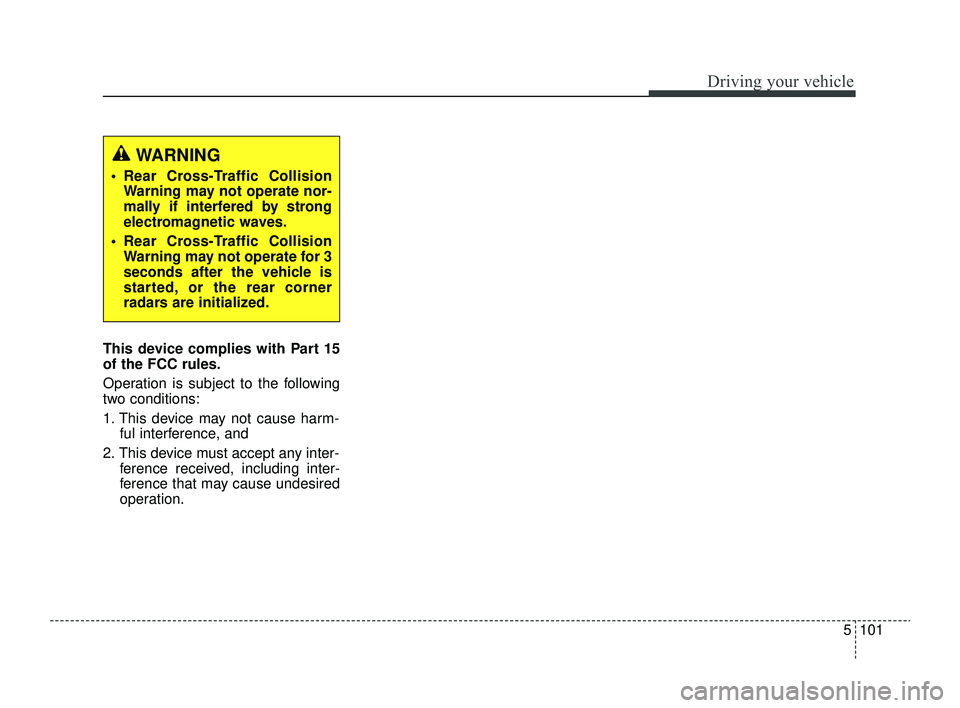
5101
Driving your vehicle
This device complies with Part 15
of the FCC rules.
Operation is subject to the following
two conditions:
1. This device may not cause harm-ful interference, and
2. This device must accept any inter- ference received, including inter-
ference that may cause undesired
operation.
WARNING
Rear Cross-Traffic CollisionWarning may not operate nor-
mally if interfered by strong
electromagnetic waves.
Rear Cross-Traffic Collision Warning may not operate for 3
seconds after the vehicle is
started, or the rear corner
radars are initialized.
SC PE USA 5.QXP 9/9/2021 6:22 PM Page 101
Page 336 of 528
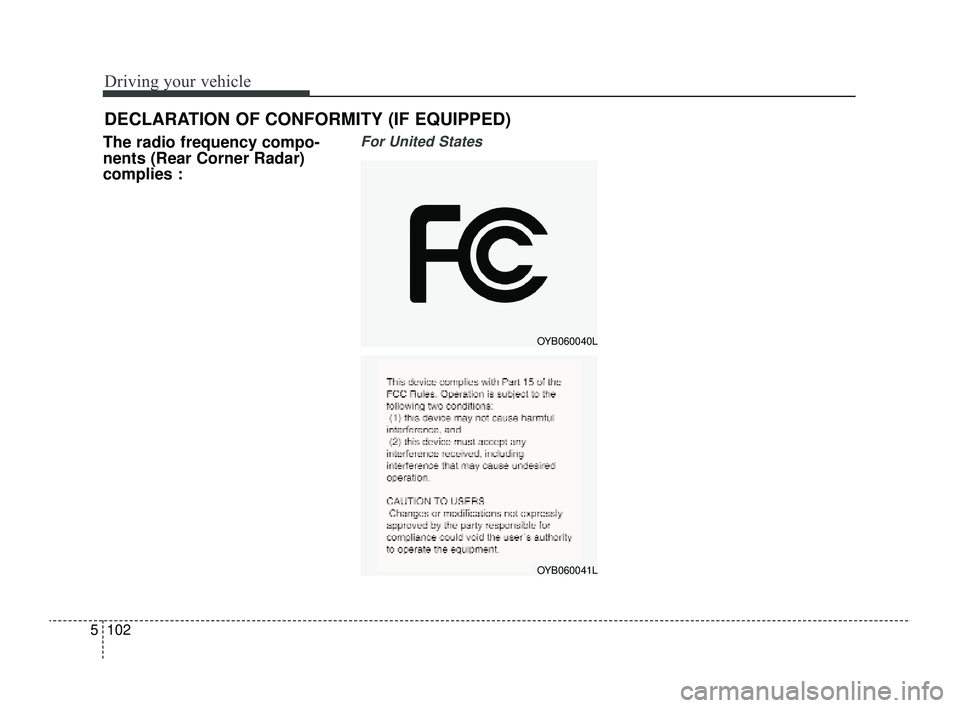
Driving your vehicle
102
5
The radio frequency compo-
nents (Rear Corner Radar)
complies :For United States
DECLARATION OF CONFORMITY (IF EQUIPPED)
OYB060040L
OYB060041L
SC PE USA 5.QXP 9/9/2021 6:22 PM Page 102
Page 337 of 528
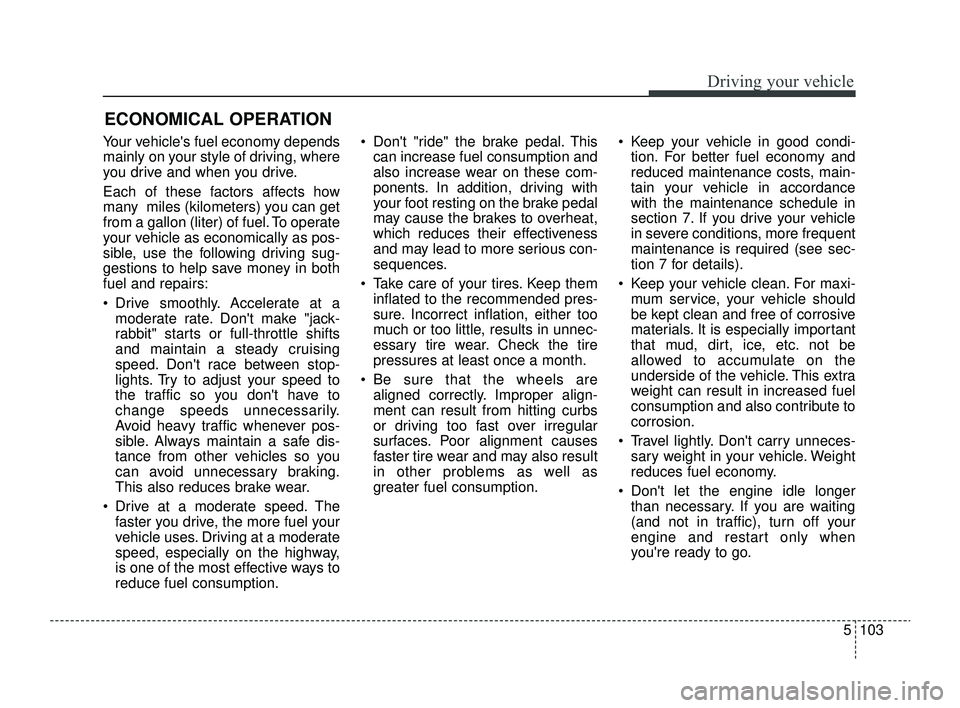
5103
Driving your vehicle
Your vehicle's fuel economy depends
mainly on your style of driving, where
you drive and when you drive.
Each of these factors affects how
many miles (kilometers) you can get
from a gallon (liter) of fuel. To operate
your vehicle as economically as pos-
sible, use the following driving sug-
gestions to help save money in both
fuel and repairs:
Drive smoothly. Accelerate at amoderate rate. Don't make "jack-
rabbit" starts or full-throttle shifts
and maintain a steady cruising
speed. Don't race between stop-
lights. Try to adjust your speed to
the traffic so you don't have to
change speeds unnecessarily.
Avoid heavy traffic whenever pos-
sible. Always maintain a safe dis-
tance from other vehicles so you
can avoid unnecessary braking.
This also reduces brake wear.
Drive at a moderate speed. The faster you drive, the more fuel your
vehicle uses. Driving at a moderate
speed, especially on the highway,
is one of the most effective ways to
reduce fuel consumption. Don't "ride" the brake pedal. This
can increase fuel consumption and
also increase wear on these com-
ponents. In addition, driving with
your foot resting on the brake pedal
may cause the brakes to overheat,
which reduces their effectiveness
and may lead to more serious con-
sequences.
Take care of your tires. Keep them inflated to the recommended pres-
sure. Incorrect inflation, either too
much or too little, results in unnec-
essary tire wear. Check the tire
pressures at least once a month.
Be sure that the wheels are aligned correctly. Improper align-
ment can result from hitting curbs
or driving too fast over irregular
surfaces. Poor alignment causes
faster tire wear and may also result
in other problems as well as
greater fuel consumption. Keep your vehicle in good condi-
tion. For better fuel economy and
reduced maintenance costs, main-
tain your vehicle in accordance
with the maintenance schedule in
section 7. If you drive your vehicle
in severe conditions, more frequent
maintenance is required (see sec-
tion 7 for details).
Keep your vehicle clean. For maxi- mum service, your vehicle should
be kept clean and free of corrosive
materials. It is especially important
that mud, dirt, ice, etc. not be
allowed to accumulate on the
underside of the vehicle. This extra
weight can result in increased fuel
consumption and also contribute to
corrosion.
Travel lightly. Don't carry unneces- sary weight in your vehicle. Weight
reduces fuel economy.
Don't let the engine idle longer than necessary. If you are waiting
(and not in traffic), turn off your
engine and restart only when
you're ready to go.
ECONOMICAL OPERATION
SC PE USA 5.QXP 9/9/2021 6:22 PM Page 103
Page 338 of 528
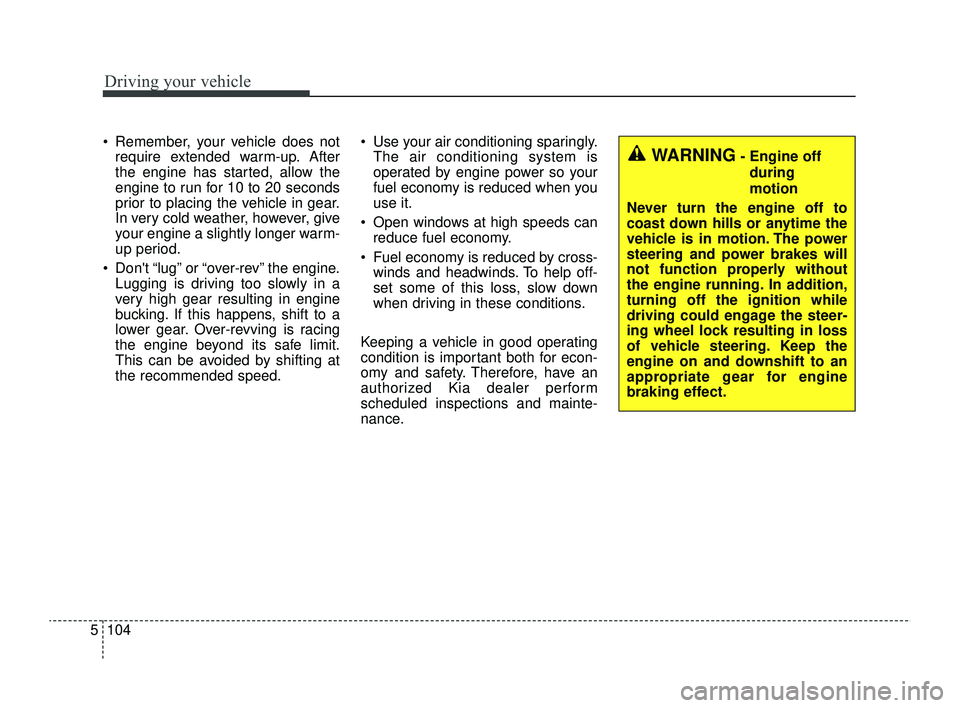
Driving your vehicle
104
5
Remember, your vehicle does not
require extended warm-up. After
the engine has started, allow the
engine to run for 10 to 20 seconds
prior to placing the vehicle in gear.
In very cold weather, however, give
your engine a slightly longer warm-
up period.
Don't “lug” or “over-rev” the engine. Lugging is driving too slowly in a
very high gear resulting in engine
bucking. If this happens, shift to a
lower gear. Over-revving is racing
the engine beyond its safe limit.
This can be avoided by shifting at
the recommended speed. Use your air conditioning sparingly.
The air conditioning system is
operated by engine power so your
fuel economy is reduced when you
use it.
Open windows at high speeds can reduce fuel economy.
Fuel economy is reduced by cross- winds and headwinds. To help off-
set some of this loss, slow down
when driving in these conditions.
Keeping a vehicle in good operating
condition is important both for econ-
omy and safety. Therefore, have an
authorized Kia dealer perform
scheduled inspections and mainte-
nance.
WARNING- Engine off during
motion
Never turn the engine off to
coast down hills or anytime the
vehicle is in motion. The power
steering and power brakes will
not function properly without
the engine running. In addition,
turning off the ignition while
driving could engage the steer-
ing wheel lock resulting in loss
of vehicle steering. Keep the
engine on and downshift to an
appropriate gear for engine
braking effect.
SC PE USA 5.QXP 9/9/2021 6:22 PM Page 104
Page 339 of 528
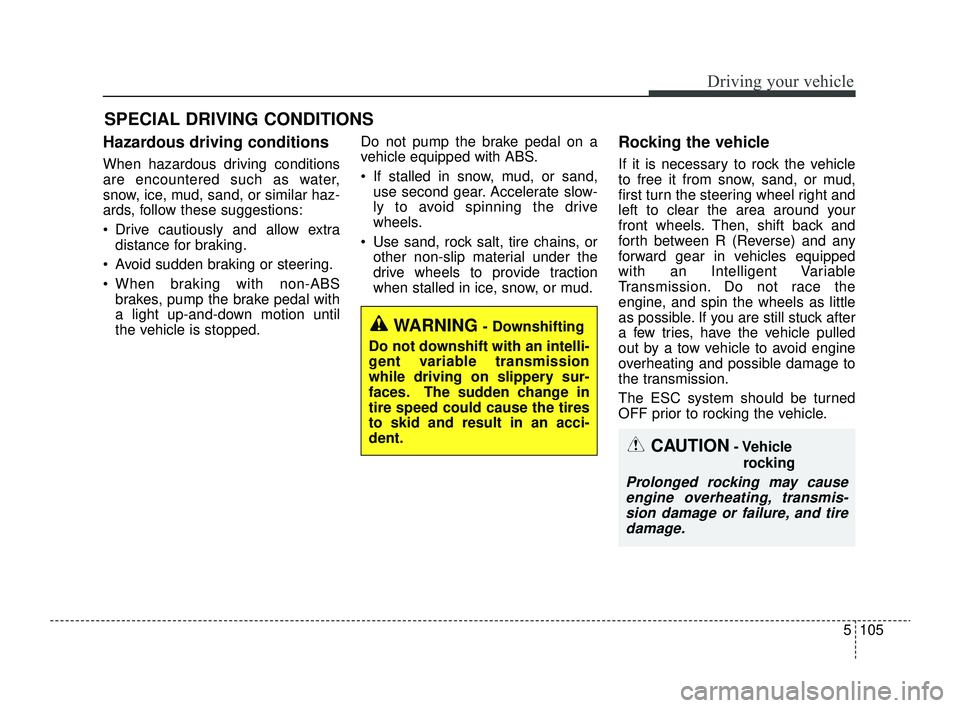
5105
Driving your vehicle
Hazardous driving conditions
When hazardous driving conditions
are encountered such as water,
snow, ice, mud, sand, or similar haz-
ards, follow these suggestions:
Drive cautiously and allow extradistance for braking.
Avoid sudden braking or steering.
When braking with non-ABS brakes, pump the brake pedal with
a light up-and-down motion until
the vehicle is stopped. Do not pump the brake pedal on a
vehicle equipped with ABS.
If stalled in snow, mud, or sand,
use second gear. Accelerate slow-
ly to avoid spinning the drive
wheels.
Use sand, rock salt, tire chains, or other non-slip material under the
drive wheels to provide traction
when stalled in ice, snow, or mud.
Rocking the vehicle
If it is necessary to rock the vehicle
to free it from snow, sand, or mud,
first turn the steering wheel right and
left to clear the area around your
front wheels. Then, shift back and
forth between R (Reverse) and any
forward gear in vehicles equipped
with an Intelligent Variable
Transmission. Do not race the
engine, and spin the wheels as little
as possible. If you are still stuck after
a few tries, have the vehicle pulled
out by a tow vehicle to avoid engine
overheating and possible damage to
the transmission.
The ESC system should be turned
OFF prior to rocking the vehicle.
SPECIAL DRIVING CONDITIONS
CAUTION- Vehicle
rocking
Prolonged rocking may causeengine overheating, transmis-sion damage or failure, and tiredamage.
WARNING- Downshifting
Do not downshift with an intelli-
gent variable transmission
while driving on slippery sur-
faces. The sudden change in
tire speed could cause the tires
to skid and result in an acci-
dent.
SC PE USA 5.QXP 9/9/2021 6:22 PM Page 105
Page 340 of 528
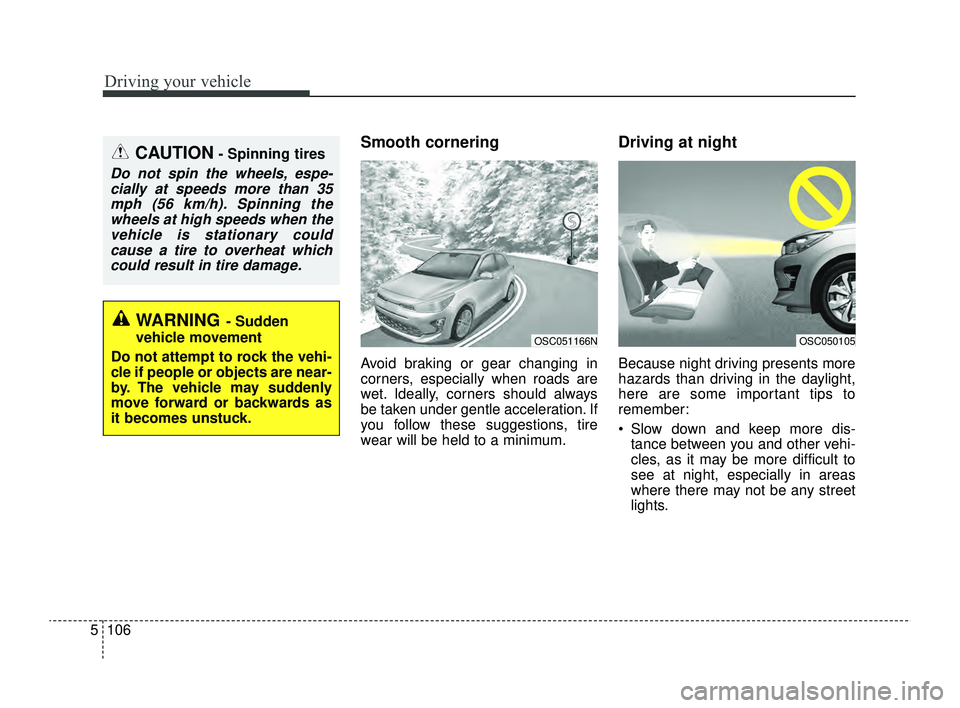
Driving your vehicle
106
5
Smooth cornering
Avoid braking or gear changing in
corners, especially when roads are
wet. Ideally, corners should always
be taken under gentle acceleration. If
you follow these suggestions, tire
wear will be held to a minimum.
Driving at night
Because night driving presents more
hazards than driving in the daylight,
here are some important tips to
remember:
Slow down and keep more dis-
tance between you and other vehi-
cles, as it may be more difficult to
see at night, especially in areas
where there may not be any street
lights.
OSC051166NOSC050105
WARNING- Sudden
vehicle movement
Do not attempt to rock the vehi-
cle if people or objects are near-
by. The vehicle may suddenly
move forward or backwards as
it becomes unstuck.
CAUTION- Spinning tires
Do not spin the wheels, espe- cially at speeds more than 35mph (56 km/h). Spinning thewheels at high speeds when thevehicle is stationary couldcause a tire to overheat whichcould result in tire damage.
SC PE USA 5.QXP 9/9/2021 6:22 PM Page 106